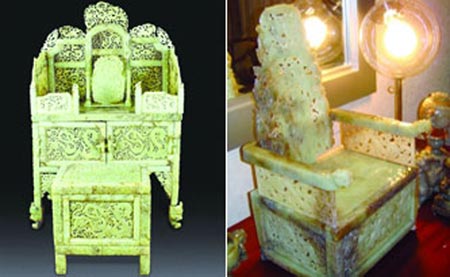
The Han Dynasty jadeware, a dressing table and a stool, was claimed to be of high historical value and worthy of collection.
(Ecns.cn)--Controversy over the authenticity of a set of carved Han Dynasty jadeware pieces, which auctioned for 220 million yuan (US$34.9 million) and were the most expensive jade articles on the Chinese art market last year, has brought Zhou Nanquan, former senior jade researcher at the Palace Museum in Beijing, under the spotlight for possible fraud, reports the state-run Xinhua News Agency.
The set was sold by Beijing Zhongjia International Auctions, which describes the 138kg dressing table and 35kg stool as being from the Han Dynasty (206 BC-220 AD), and claims that the pieces are of high historical value and worthy of collection.
The set eventually sold for 40 million yuan above the starting price, yet soon after the sale, rumors began swirling online that the jade stool was a forgery. Many of the criticisms have centered on the possibility that the set would not have been used in the Han Dynasty.
"During the Han dynasty, Chinese people sat on the floor, not on stools," said Liu Qingzhu, an archaeologist and former director of the Institute of Archaeology at the Chinese Academy of Social Sciences, implying that such a stool had not even been invented at the time.
Li Weihan, an expert from the China National Arts and Crafts Society, told the South China Morning Post that jade pieces made in the Han dynasty were primarily wine goblets or containers used to offer sacrifices, and that jade would not have been used to make items for daily use.
"It's impossible that there were jade dressing tables and stools in the Han dynasty," he claimed.
The controversy was further fueled after Zhao Jun, a craftsman in Pizhou city of Jiangsu Province, admitted last month to making the items from materials from the Ming Dynasty (1368-1644).
Zhao said he made the stool in 2010 and sold it to a buyer surnamed Wang in Shijiazhuang, Hebei Province, for 2.6 million yuan, adding that the cost of the materials was over 1 million yuan.
An insider of the art auction market pointed out that it is likely the buyer had been cheated, speculating that the deal might have been related to money laundering or loan fraud.
Many Internet users agreed, analyzing that a buyer would not make such a purchase unless the items were authenticated by experts who could identify fakes easily.
At this, Zhou Nanquan argued in an exclusive interview with Xinhua last Thursday that "we (Zhou and other experts) are only responsible for checking the authenticity of the antiques, and have nothing to do with the auction prices."
Speaking of his relationship with Beijing Zhongjia, Zhou explained that he serves as a consultant and is paid 600 yuan every month, but does not officially belong to the company.
Zhou told Xinhua that "until now, I still stick to my appraisal of the jade articles," which are made of huge, rare Hetian jade and carved with dragon and phoenix patterns. "The texture, color, design and craftsmanship of the pieces suggest that they originate from the Han Dynasty," Zhou added.
He also stressed that he has checked hundreds of thousands of jade objects, and "all the judgments were based on long experience and deep knowledge. By now, no real experts have questioned my appraisals," he said.
But Ma Weidu, an art collector in Beijing, told the Shenzhen Daily that there is room for doubt, since "there's a chance that the functions of the auctioned pieces were misinterpreted。"
The controversy reflects a deep distrust of the art market, where in some extreme cases art auctions have been used for money laundering, commented Xinhua.
Mao Xiaohu, director of the Beijing Huaxia Ancient Ceramics Identification Research Institute, told the Global Times that current laws have loopholes that exempt auction companies from responsibility when fake pieces are sold. Meanwhile, the official commissions for cultural relics identification do not shoulder the responsibility of identifying items that auction companies sell.
"Such commissions only identify cultural relics for state-owned museums or organization, leaving the antiques market uncontrolled," Mao noted.
Zhang Jinfa, owner of a cultural relics identification center in Beijing, suggested in an interview with the Yangcheng Evening News that a strict system of performance appraisal for experts should be created.
"Currently, certificates of professional qualification for experts—which are issued by a training center under the Ministry of Human Resources and Social Security—are hardly relevant to their level of skill," Zhang pointed out.

Copyright ©1999-2011 Chinanews.com. All rights reserved.
Reproduction in whole or in part without permission is prohibited.